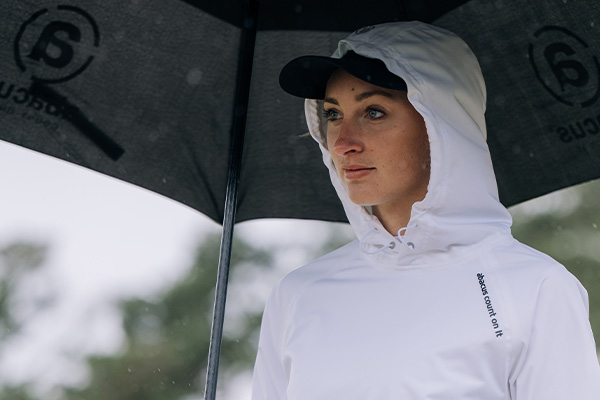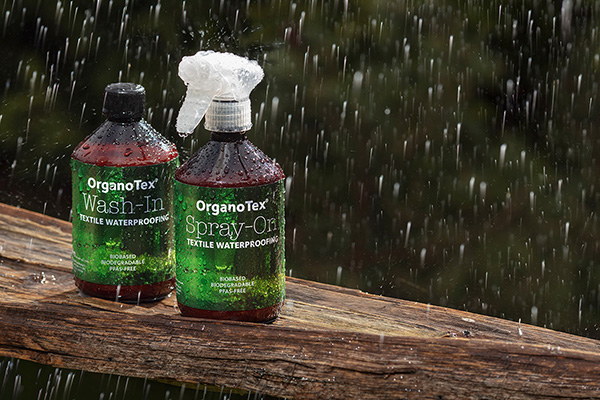
How to take care of your rainwear
Rainwear using impregnation agents that are completely free from PFC are better for the environment as no fluorocarbons are released into nature. Those substances cannot break down and instead accumulate in organisms, affecting plants, animals, and humans alike. By choosing garments free from fluorocarbons/PFC, you are making an active choice to protect nature from these harmful substances. All our waterproofs manufactured today are PFC-free. Since you are choosing garments with biodegradable impregnation, you will need to re-impregnate your rainwear from time to time to maintain its high level of waterproofing and water-repellent function.
After use
- Shake off and hang your rainwear properly spread out each time it gets wet, allowing it to dry thoroughly.
- If your rainwear gets visibly dirty, such as at the bottom of the trousers, wipe off the dirt with a damp cloth.
- Between golf rounds, rainwear is best stored hanging on a hanger rather than folded in a drawer or stuffed into a golf bag.

Washing
When clothes get dirty, the fabric’s pores (on both the inside and outside) become clogged, reducing properties such as breathability. It is therefore important to wash your rainwear regularly—especially since breathability is one of the key features that ensure comfort on the golf course. Washing and drying your rainwear correctly can also help reactivate the impregnation treatment.
When clothes get dirty, the fabric’s pores (on both the inside and outside) become clogged, reducing properties such as breathability. It is therefore important to wash your rainwear regularly—especially since breathability is one of the key features that ensure comfort on the golf course. Washing and drying your rainwear correctly can also help reactivate the impregnation treatment.
How to wash your rainwear:
- Use a liquid detergent designed for functional garments. Do not use powdered detergent!
- Wash at a maximum of 30°C on a program with low spin speed.
- Avoid fabric softener, as it wears down the fabric and leaves a coating that reduces functionality.
- If your washing machine has a sportswear program, use it to ensure that no fabric softener residue remains in the system. Otherwise, wipe out the detergent compartment before washing.
- Before placing the garment in the machine, smooth it out so it is not crumpled or folded, and loosen any drawstrings at the neck or waist to ensure thorough cleaning.
- Close all Velcro fastenings and zippers to prevent unnecessary wear on the fabric.

Re-Impregnation
If you have washed and dried your rainwear regularly but notice that water no longer beads up and rolls off the outer fabric, it’s time to re-impregnate. This will maximize the garment’s performance and lifespan.
When water soaks into the fabric, it is stopped by the waterproof membrane. However, if the outer fabric becomes saturated with moisture, breathability can be compromised, making the garment feel heavy and cold. It may even feel damp inside, as body moisture is unable to escape, leaving you wet from the inside.
How to re-impregnate your rainwear:
- The garment must be clean before re-impregnation, or else dirt and grease will get sealed in, reducing functionality. First, wash the garment following the instructions above and leave it in the washing machine.
- Wipe out the detergent compartment to remove any residue.
- Shake the bottle of re-impregnation agent well. We recommend using a biodegradable wash-in textile waterproofing treatment. This restores the outer fabric’s water-repellent function, optimizing breathability—one of the most important features in rainwear for active sports like golf.
- Dose the impregnation agent in the detergent compartment according to the instructions on the bottle, but never re-impregnate more than three garments at a time.
- Run a short wash cycle and dry the garment immediately afterward.
Drying
Whether you have only washed or also re-impregnated your rainwear, you will achieve the best results by drying it in a tumble dryer or drying cabinet. Heat helps seal or reactivate the impregnation. However, always use a low-temperature setting to protect delicate details on the garment. If you do not have access to a drying cabinet or tumble dryer, let the garment air dry in the warmest indoor location possible.

How to take care of your waterproofs
Rainwear using impregnation agents that are completely free from PFC are better for the environment as no fluorocarbons are released into nature. Those substances cannot break down and instead accumulate in organisms, affecting plants, animals, and humans alike. By choosing garments free from fluorocarbons/PFC, you are making an active choice to protect nature from these harmful substances. All our waterproofs manufactured today are PFC-free. Since you are choosing garments with biodegradable impregnation, you will need to re-impregnate your rainwear from time to time to maintain its high level of waterproofing and water-repellent function.
After Use
• Shake off and hang your rainwear properly spread out each time it gets wet, allowing it to dry thoroughly.
• If your rainwear gets visibly dirty, such as at the bottom of the trousers, wipe off the dirt with a damp cloth.
• Between golf rounds, rainwear is best stored hanging on a hanger rather than folded in a drawer or stuffed into a golf bag.
Washing
When clothes get dirty, the fabric’s pores (on both the inside and outside) become clogged, reducing properties such as breathability. It is therefore important to wash your rainwear regularly—especially since breathability is one of the key features that ensure comfort on the golf course. Washing and drying your rainwear correctly can also help reactivate the impregnation treatment.
How to wash your rainwear:
• Use a liquid detergent designed for functional garments. Do not use powdered detergent!
• Wash at a maximum of 30°C on a program with low spin speed.
• Avoid fabric softener, as it wears down the fabric and leaves a coating that reduces functionality.
• If your washing machine has a sportswear program, use it to ensure that no fabric softener residue remains in the system. Otherwise, wipe out the detergent compartment before washing.
• Before placing the garment in the machine, smooth it out so it is not crumpled or folded, and loosen any drawstrings at the neck or waist to ensure thorough cleaning.
• Close all Velcro fastenings and zippers to prevent unnecessary wear on the fabric.
When clothes get dirty, the fabric’s pores (on both the inside and outside) become clogged, reducing properties such as breathability. It is therefore important to wash your rainwear regularly—especially since breathability is one of the key features that ensure comfort on the golf course. Washing and drying your rainwear correctly can also help reactivate the impregnation treatment.
How to wash your rainwear:
• Use a liquid detergent designed for functional garments. Do not use powdered detergent!
• Wash at a maximum of 30°C on a program with low spin speed.
• Avoid fabric softener, as it wears down the fabric and leaves a coating that reduces functionality.
• If your washing machine has a sportswear program, use it to ensure that no fabric softener residue remains in the system. Otherwise, wipe out the detergent compartment before washing.
• Before placing the garment in the machine, smooth it out so it is not crumpled or folded, and loosen any drawstrings at the neck or waist to ensure thorough cleaning.
• Close all Velcro fastenings and zippers to prevent unnecessary wear on the fabric.

Re-Impregnation
If you have washed and dried your rainwear regularly but notice that water no longer beads up and rolls off the outer fabric, it’s time to re-impregnate. This will maximize the garment’s performance and lifespan.
When water soaks into the fabric, it is stopped by the waterproof membrane. However, if the outer fabric becomes saturated with moisture, breathability can be compromised, making the garment feel heavy and cold. It may even feel damp inside, as body moisture is unable to escape, leaving you wet from the inside.
How to re-impregnate your rainwear:
• The garment must be clean before re-impregnation, or else dirt and grease will get sealed in, reducing functionality. First, wash the garment following the instructions above and leave it in the washing machine.
• Wipe out the detergent compartment to remove any residue.
• Shake the bottle of re-impregnation agent well. We recommend using a biodegradable wash-in textile waterproofing treatment. This restores the outer fabric’s water-repellent function, optimizing breathability—one of the most important features in rainwear for active sports like golf.
• Dose the impregnation agent in the detergent compartment according to the instructions on the bottle, but never re-impregnate more than three garments at a time.
• Run a short wash cycle and dry the garment immediately afterward.
Drying
Whether you have only washed or also re-impregnated your rainwear, you will achieve the best results by drying it in a tumble dryer or drying cabinet. Heat helps seal or reactivate the impregnation. However, always use a low-temperature setting to protect delicate details on the garment. If you do not have access to a drying cabinet or tumble dryer, let the garment air dry in the warmest indoor location possible.
• The garment must be clean before re-impregnation, or else dirt and grease will get sealed in, reducing functionality. First, wash the garment following the instructions above and leave it in the washing machine.
• Wipe out the detergent compartment to remove any residue.
• Shake the bottle of re-impregnation agent well. We recommend using a biodegradable wash-in textile waterproofing treatment. This restores the outer fabric’s water-repellent function, optimizing breathability—one of the most important features in rainwear for active sports like golf.
• Dose the impregnation agent in the detergent compartment according to the instructions on the bottle, but never re-impregnate more than three garments at a time.
• Run a short wash cycle and dry the garment immediately afterward.
Drying
Whether you have only washed or also re-impregnated your rainwear, you will achieve the best results by drying it in a tumble dryer or drying cabinet. Heat helps seal or reactivate the impregnation. However, always use a low-temperature setting to protect delicate details on the garment. If you do not have access to a drying cabinet or tumble dryer, let the garment air dry in the warmest indoor location possible.



